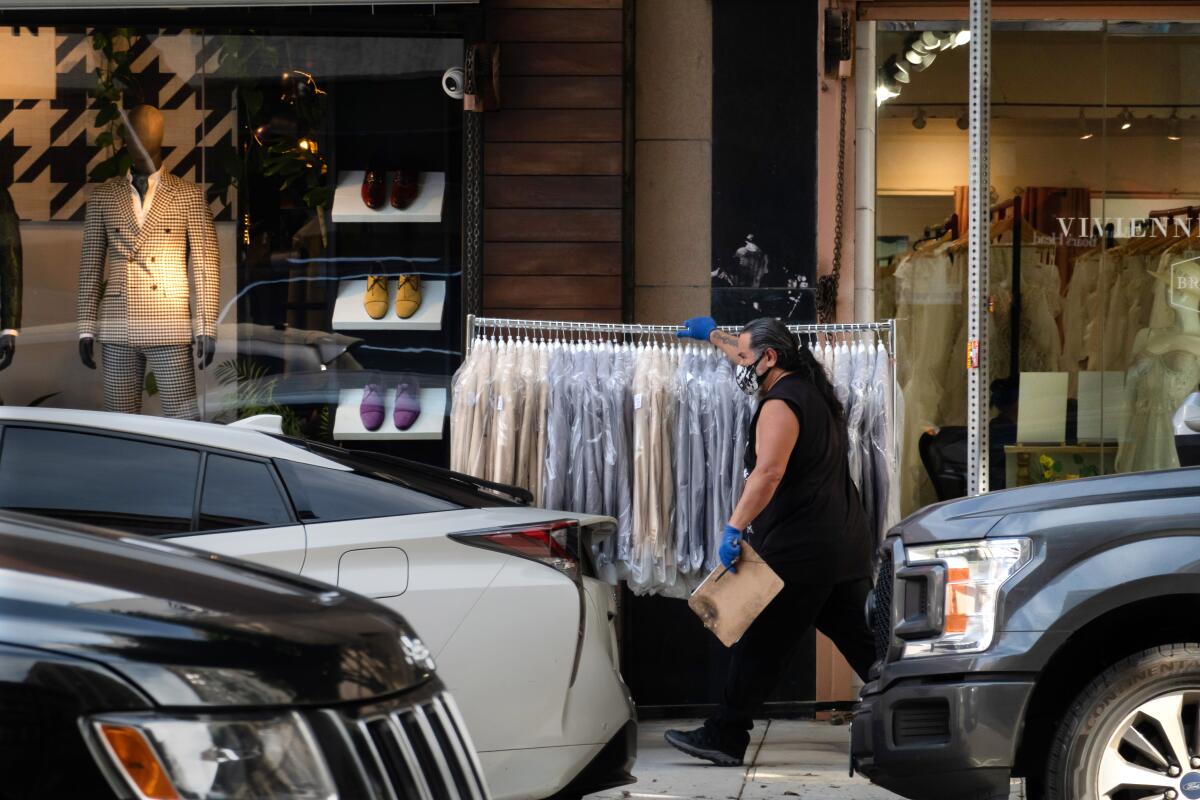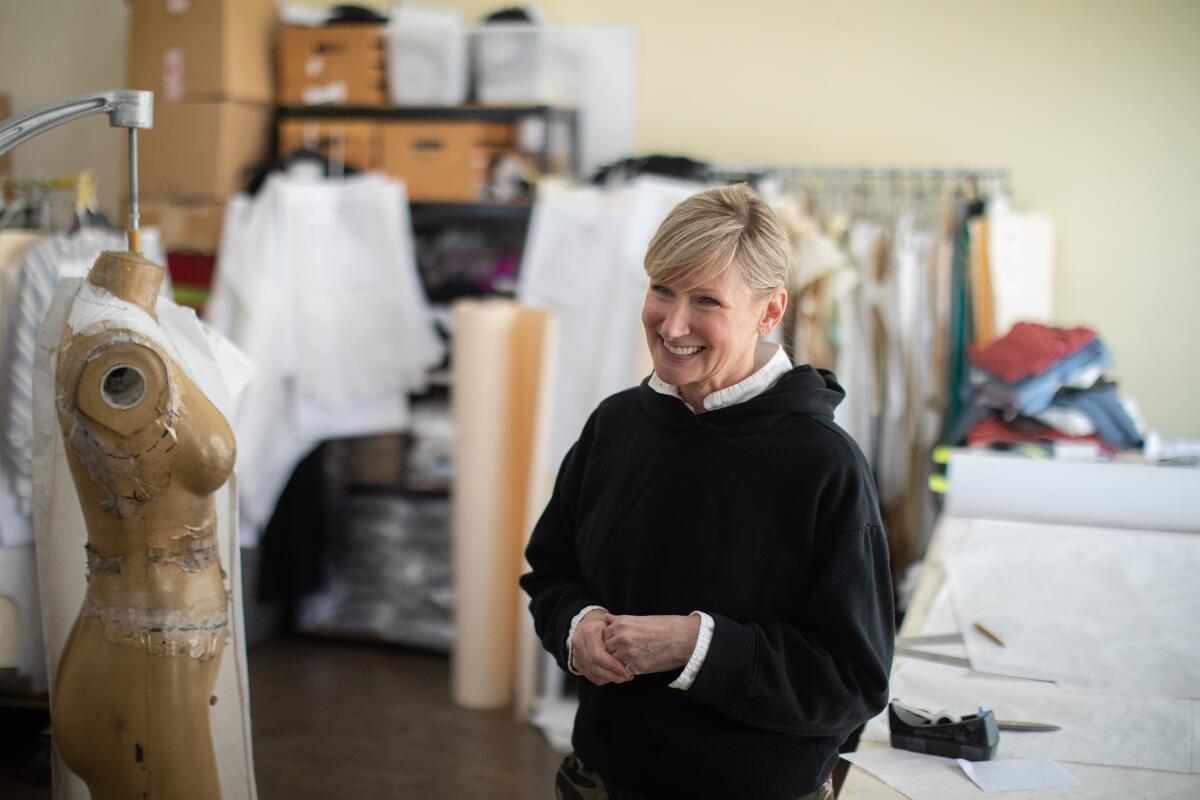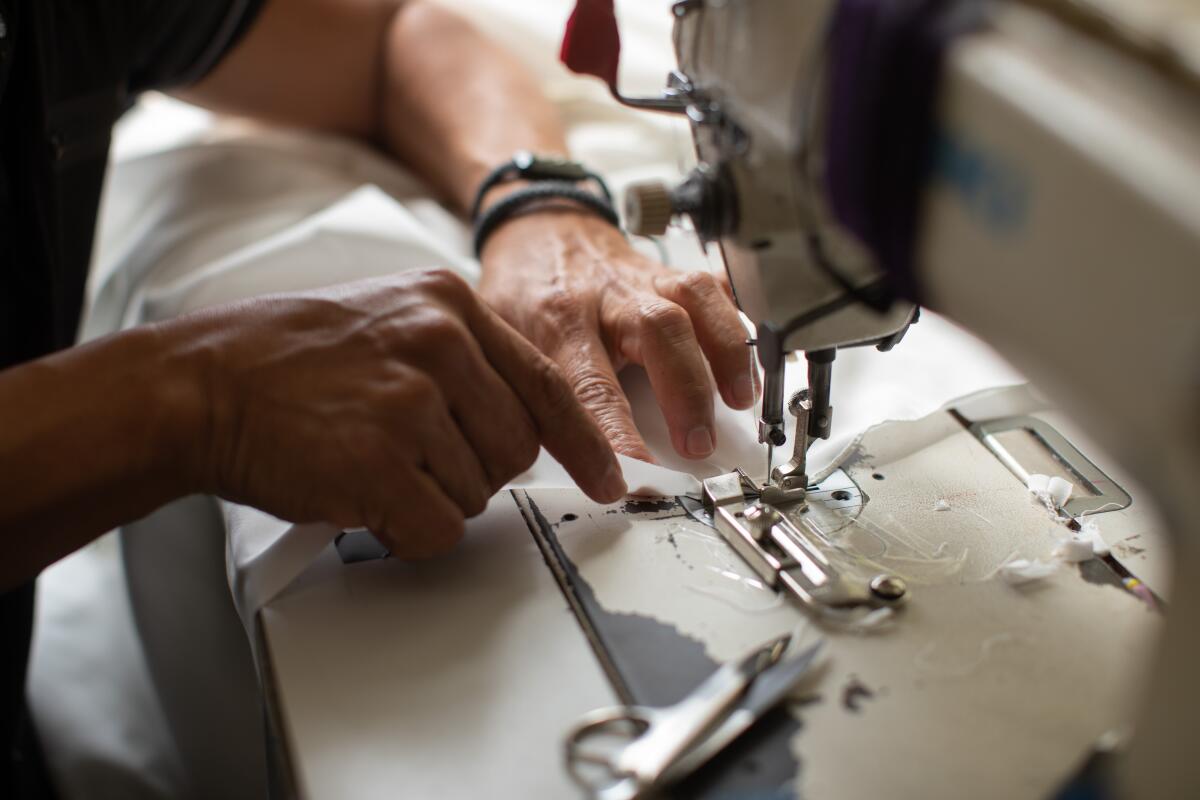The garment industry, excluded from downtown planning, finally gets to have its say

- Share via
For the past decade, city planners and stakeholders in downtown Los Angeles have been crafting a plan that would set the area’s development priorities for the area for the next 20 years.
But for most of that time, the DTLA 2040 plan didn’t include input from garment workers, said Daisy Gonzalez, campaign director for the Garment Worker Center, which organizes and advocates for the industry.
“We were left out of this process for seven years,” Gonzalez said.
And when they did learn of the plan, it wasn’t from the city — allies in the hotel workers’ union alerted them to it in 2021, Gonzalez said.
The plan creates zoning for 100,000 more residential units downtown, and would have allowed residential development in areas traditionally occupied by the garment industry, sparking concerns of displacement and job loss.
Last week’s amendments to the plan include protections for an estimated 20,000 downtown garment workers. The council’s Planning and Land Use Management committee also voted to increase the amount of manufacturing space required for new housing developments in the Fashion District and added a requirement to include freight elevators and loading docks for manufacturing.
Those changes adopted last week are long overdue and represent a significant win for an overlooked but essential industry and its workers.
Some have decried the move as a last-minute change that jeopardize housing production — city analysts estimated that the amendments would make as many as 12,000 of the planned units for downtown “financially unfeasible.”
But it’s dishonest to exclude garment workers for seven years and complain that there’s not enough time to plan around their needs. The plan should have been built around their needs in the first place.
The Fashion District’s network of sewers, designers, dyers and small manufacturing facilities form a human supply chain that has powered Los Angeles’ fashion and creative industry for nearly a century. The industry is important not just to Southern California’s economy, but also to the fashion industry nationwide.
Los Angeles’ garment industry is about 40,000 workers strong and accounts for about 83% of the nation’s cut-and-sew manufacturing, according to a city staff report. The Los Angeles Metro Area accounted for 58% of registered garment industry contractors in the nation.

“This ecosystem doesn’t exist anywhere else on the planet to this scale. I could have never built the business anywhere else,” said Mary Price, founder of Ocean and Main, a clothing label based in downtown Los Angeles whose products have been stocked at Neiman Marcus and Bergdorf Goodman.
The pandemic caused painful disruptions in overseas supply chains. Afterward, large fashion brands sought to “nearshore” their supply chains, consolidating their production process to reduce travel time and cost.
Price says most brands are trying to respond to a huge demand for sustainable fashion. That means there’s a lot of potential for growth in the Fashion District.

Price’s sewers are within blocks of her design studio. She can walk across the street and order 2,000 yards of high-quality fabric. Other local companies allow her to reuse leftover fabrics from production in a process called upcycling.
Overproduction and waste are a huge environmental issue in the clothing industry, which accounts for about 10% percent of global greenhouse gas emissions and consumes more energy than the aviation and shipping industries combined, according to a United Nations report.
What’s more, these jobs have represented a significant portion of the work that’s accessible to low-income immigrants and folks without English fluency. The garment industry’s workers primarily live in the Westlake and MacArthur Park neighborhoods, two of the last affordable areas in the city.
Displacing the garment industry would force those workers, many of whom cannot afford a car, to move or face impractically long bus commutes.
Politicians and boosters love to wax poetic about how Los Angeles is a city of immigrants. I wonder if they understand that it’s these jobs and these neighborhoods that make it so. Putting the garment industry at risk not only puts people out of work, but also jeopardizes affordability in Los Angeles.

Historically, the manufacturing industry was one of the primary reasons Los Angeles was an affordable city. Factory owners wanted cheap housing near their facilities to house their workers. In no small part because of that, Los Angeles became a place where immigrants and former slaves could earn a living and own a home.
Councilwoman Eunisses Hernandez’s mother was a garment worker, and Hernandez’s childhood memories are filled with the clean scent of new linen and and starch. Her mother raised their family on the income, and now they own their home. But they could have “never done it alone,” Hernandez said.
“Without a doubt, I think things are getting harder for immigrants in Los Angeles. When I knock on doors, we see generations sharing a bedroom, people impacted by the lack of affordable housing and gentrification,” Hernandez said.
Gentrification in downtown Los Angeles has caused hardship for some garment workers, such as Jessica Chavez’s mom. Chavez, 15, said her mom lost her job recently because there’s less work available. Many of the sewers and contractors she grew up seeing are now vacant retail and residential properties.
Chavez, the oldest of three, grew up knowing that iPhones and Apple products were out of reach for their family. They don’t have a car, and the family of five shares a single room where every conversation is overheard.
She spent a lot of time with her parents in the garment district, and she saw the long hours they spent crouched in a chair take a physical toll on their health. But she didn’t understand why their life was so hard until she joined the Garment Worker Center’s youth program and learned about wage theft, piecemeal pay and gentrification.
“I felt like my innocence was taken away. Struggling felt so normal, I didn’t know any better,” Chavez said.
If the choice is between 12,000 more housing units downtown, only a fraction of which would be affordable, and 20,000 of some of the last low income jobs available in Los Angeles, that is no choice.
Protect the jobs.
More to Read
Sign up for Essential California
The most important California stories and recommendations in your inbox every morning.
You may occasionally receive promotional content from the Los Angeles Times.











